Many organizations strive to connect team efforts directly to their most important goals, but without the right tools, making that connection can be challenging. When your data is unified and accessible, true insight becomes actionable, and every team member gains visibility into how their work drives company-wide results.
This is where the right KPI software comes in, aligning strategic objectives with daily work and, with the help of AI, turning raw data into real-time, actionable insights for everyone.
This guide breaks down the top solutions — including monday work management — for smarter KPI tracking, walks you through how to choose the best fit for your business, and highlights ways to sidestep common reporting challenges.
Try monday work managementWhat is KPI software and why does it matter?
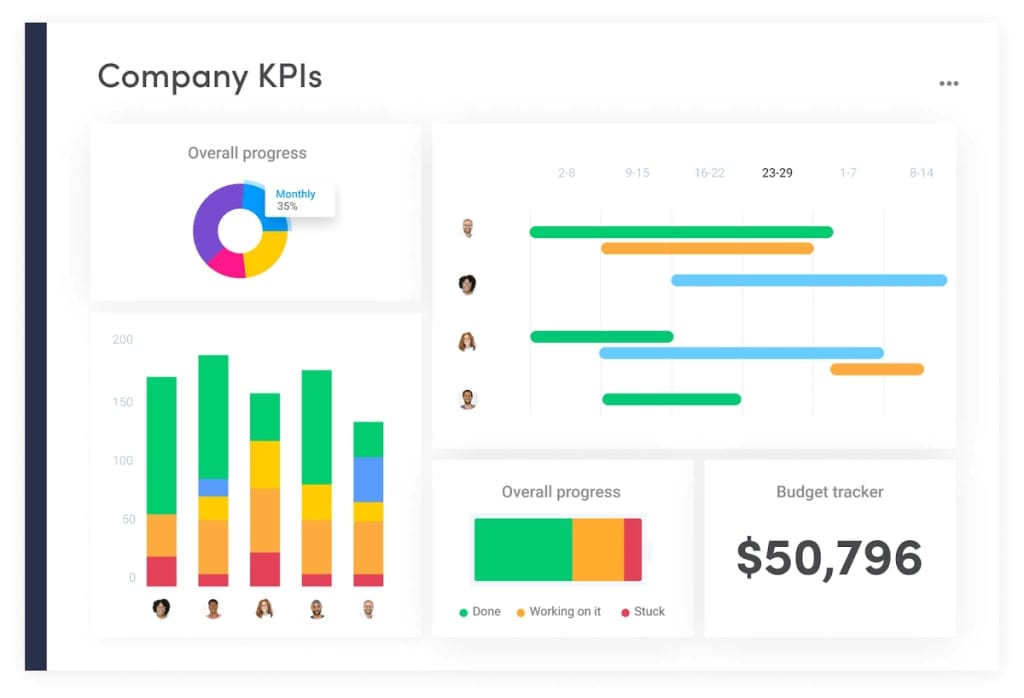
KPI software functions as a business’s central scoreboard, giving everyone a clear, real-time view of what truly matters. It cuts through the data chaos to focus your team on the specific metrics that define success and drive your organization forward.
But this is where most teams get stuck: tracking metrics in one tool while managing the actual work in another. The right platform automatically pulls your numbers together, presenting them on visual KPI dashboards so you can see progress at a glance. Smart KPI platforms use AI as an early warning system, flagging when you’re off track, explaining why performance is shifting, and even suggesting corrective actions before it’s too late.
Quick refresher: A key performance indicator (KPI) is a measurable value that shows how effectively a team or organization is achieving its goals. For example, a sales team might track monthly revenue growth, a marketing team might measure lead conversion rate, and a customer support team might monitor average response time.
10 essential KPI tools for smarter tracking in 2025
Selecting the right KPI tool means finding a platform that unlocks your team’s potential and makes it easy to connect goals with daily work. With so many options available, the best choice is the one that simplifies complexity and brings clarity to your workflow.
To help you sidestep analysis paralysis, we’ve broken down the top KPI software options in a clear comparison table below. Use this table as your shortcut to finding the platform that will become your team’s central hub for turning goals into real, measurable results — or keep reading for a deep dive into each solution.
| Platform | Use case | Free plan? | Notable feature | Starting price (paid) |
|---|---|---|---|---|
| monday work management | Unified KPI tracking and workflow automation for any team | Yes | No-code dashboards that tie KPIs directly to projects | $9/seat/month |
| Tableau | Advanced analytics and deep data visualization | No | Interactive, highly customizable dashboards | $42/user/month |
| Power BI | Real-time KPI dashboards within the Microsoft ecosystem | Yes | Native integration with Microsoft 365 & Excel | $14/user/month |
| Sisense | Embedded analytics and KPI tracking inside your own apps | No | AI-powered insights with embeddable dashboards | Custom pricing |
| Klipfolio | Quick setup of real-time, multi-source KPI dashboards | No | 130+ data source integrations & pre-built templates | $120/month |
| SimpleKPI | Straightforward KPI reporting for small teams | No | Extensive KPI template library and easy automation | $79/month |
| Databox | Mobile-first KPI tracking and reporting | No | AI-powered summaries and SMART goal tracking | $159/month |
| Google Analytics | Web and app performance tracking | Yes | Event-based measurement and ML-powered insights | Enterprise features: custom pricing |
| DashThis | Automated marketing KPI reporting for agencies | No | White-label customization for branded client reports | $42/month |
| Smartsheet | Spreadsheet-style KPI dashboards and project tracking | No | Excel-like interface with real-time dashboard widgets | $12/user/month |
1. monday work management
Operating on the principle that metrics should drive action, monday work management converts scattered KPIs into a unified command center where data fuels decisions, not just reporting. The platform connects performance tracking directly to your workflows, making it the go-to choice for teams who want their data to fuel better decisions rather than collect digital dust.
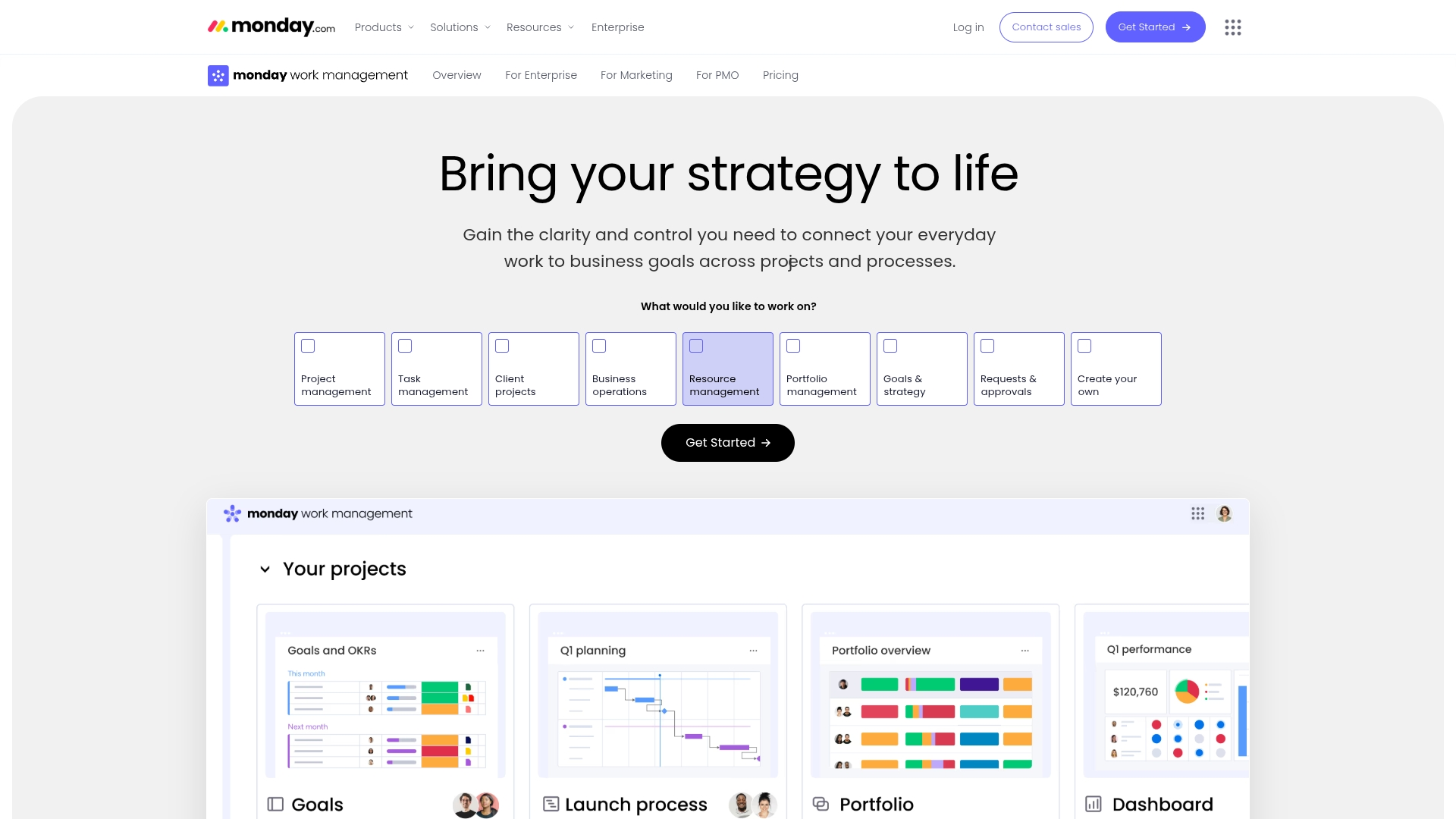
Use case: Monday work management serves as a comprehensive work operating system that seamlessly integrates KPI tracking with project execution, creating a closed loop between measurement and action.
Key features
- Customizable dashboards with 15+ widgets that pull real-time data from multiple boards and external integrations
- Automated KPI reporting that generates and distributes performance updates on scheduled intervals
- Cross-departmental tracking capabilities that connect high-level company metrics to individual task completion
Pricing
- Free: $0 forever (up to 2 seats, 3 boards, basic KPI tracking)
- Basic: $9/seat/month (unlimited items, dashboard based on 1 board, 500 AI credits)
- Standard: $12/seat/month (Timeline & Gantt views, 250 automations/month, dashboard combining 5 boards)
- Pro: $19/seat/month (private boards, time tracking, formula columns, 25,000 automations/month, dashboard combining 20 boards)
- Enterprise: Custom pricing (advanced analytics, enterprise security, dashboard combining 50 boards)
- Annual billing saves 18% compared to monthly billing
- Nonprofit discounts available
Why it stands out
- Workflow integration creates direct connections between daily tasks and strategic KPIs, eliminating the gap between execution and measurement
- AI-powered insights automatically surface performance trends and suggest optimizations based on your team’s work patterns
- No-code customization allows teams to build sophisticated KPI tracking systems without technical expertise, adapting to any business model or industry
2. Tableau
Tableau excels at weaving raw data into compelling visual stories that drive business decisions. The platform specializes in advanced data visualization and interactive dashboards, making it ideal for enterprises that need deep analytical capabilities and comprehensive KPI tracking software.
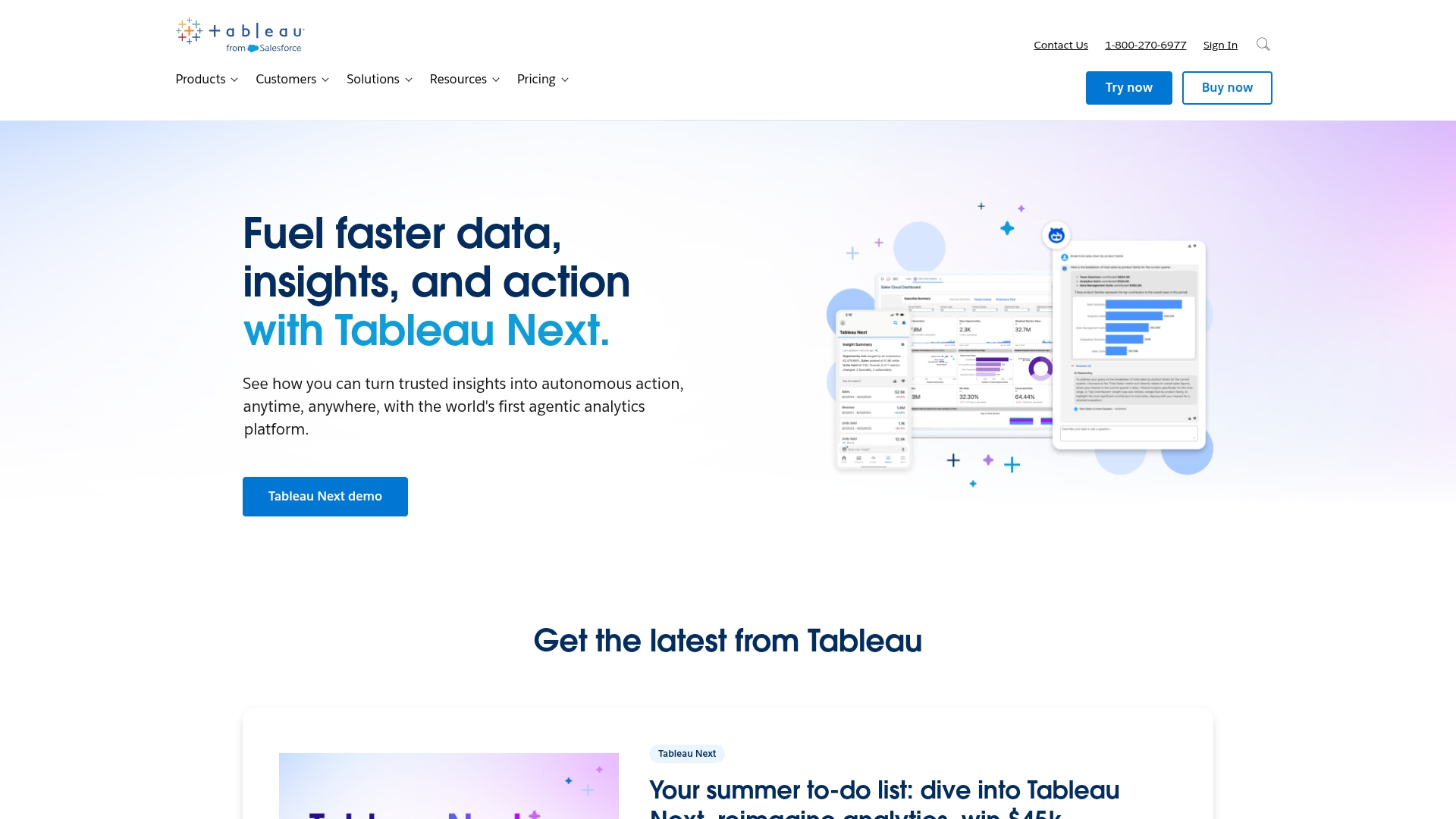
Use case: Tableau empowers organizations to create highly customized, interactive KPI dashboards that turn complex datasets into actionable insights for data-driven decision making.
Key features
- Interactive dashboards with drag-and-drop functionality for creating custom KPI visualizations
- Tableau Pulse delivers AI-powered, proactive insights on key metrics directly to your workflow
- Real-time data connectivity across multiple sources for comprehensive performance tracking
Pricing
- Tableau Creator: $42/month per user (billed annually)
- Tableau Explorer: $15/month per user (billed annually)
- Tableau+: $75/month per user (billed annually, premium cloud-only edition)
- New customers save 20% on Enterprise editions through January 31, 2026
Considerations
- Steeper learning curve for advanced features compared to simpler key performance indicators software
- Higher cost structure may not suit smaller businesses looking for basic KPI management software
3. Power BI
As Microsoft’s analytics powerhouse, Power BI unifies scattered business data into cohesive KPI dashboards that drive real decision-making. It excels at connecting diverse data sources into interactive visualizations, making it perfect for organizations already invested in the Microsoft ecosystem.
Use case: Power BI enables organizations to create comprehensive KPI tracking systems that automatically update from multiple data sources, providing real-time visibility into business performance.
Key features
- Native KPI visuals with color-coded performance indicators and trend analysis
- Centralized scorecards and metrics that can be shared across departments
- Seamless integration with Microsoft 365, Excel, and Azure for unified data workflows
Pricing
- Free Account: $0 (create and view reports, no credit card required)
- Power BI Pro: $14/month per user (paid yearly, includes publishing and sharing capabilities)
- Power BI Premium Per User: $24/month per user (paid yearly, enterprise-scale features and larger model sizes)
- Power BI Embedded: Variable pricing based on usage and capacity
- Fabric Capacity options: Variable pricing for organization-wide analytics capacity
Considerations
- Performance can slow significantly with very large datasets, potentially affecting real-time KPI monitoring
- Advanced customization requires learning DAX (Data Analysis Expressions), which has a steep learning curve for non-technical users
4. Sisense
Engineered for embedded analytics, Sisense converts complex data from multiple sources into actionable KPI insights that non-technical teams can actually use. The platform is perfect for tech companies and enterprises that need to integrate KPI tracking directly into their existing applications and workflows.
Use case: Sisense enables organizations to consolidate data from disparate sources and create interactive KPI dashboards that can be embedded directly into applications for seamless monitoring.
Key features
- Real-time interactive dashboards with drag-and-drop functionality for custom KPI visualization
- AI-powered insights that automatically surface trends and patterns in your key performance indicators
- Embedded analytics capabilities that integrate KPI tracking directly into your existing applications
Pricing
Custom pricing available upon request.
Considerations
- Advanced customization of visualizations requires coding knowledge, particularly JavaScript
- Higher price point compared to some competitors in the KPI software market
5. Klipfolio
Klipfolio provides real-time KPI dashboards that consolidate scattered business data into actionable insights, connecting over 100 data sources with pre-built metrics and visualizations. This makes it particularly valuable for small to medium businesses and marketing agencies that need quick setup without technical complexity.
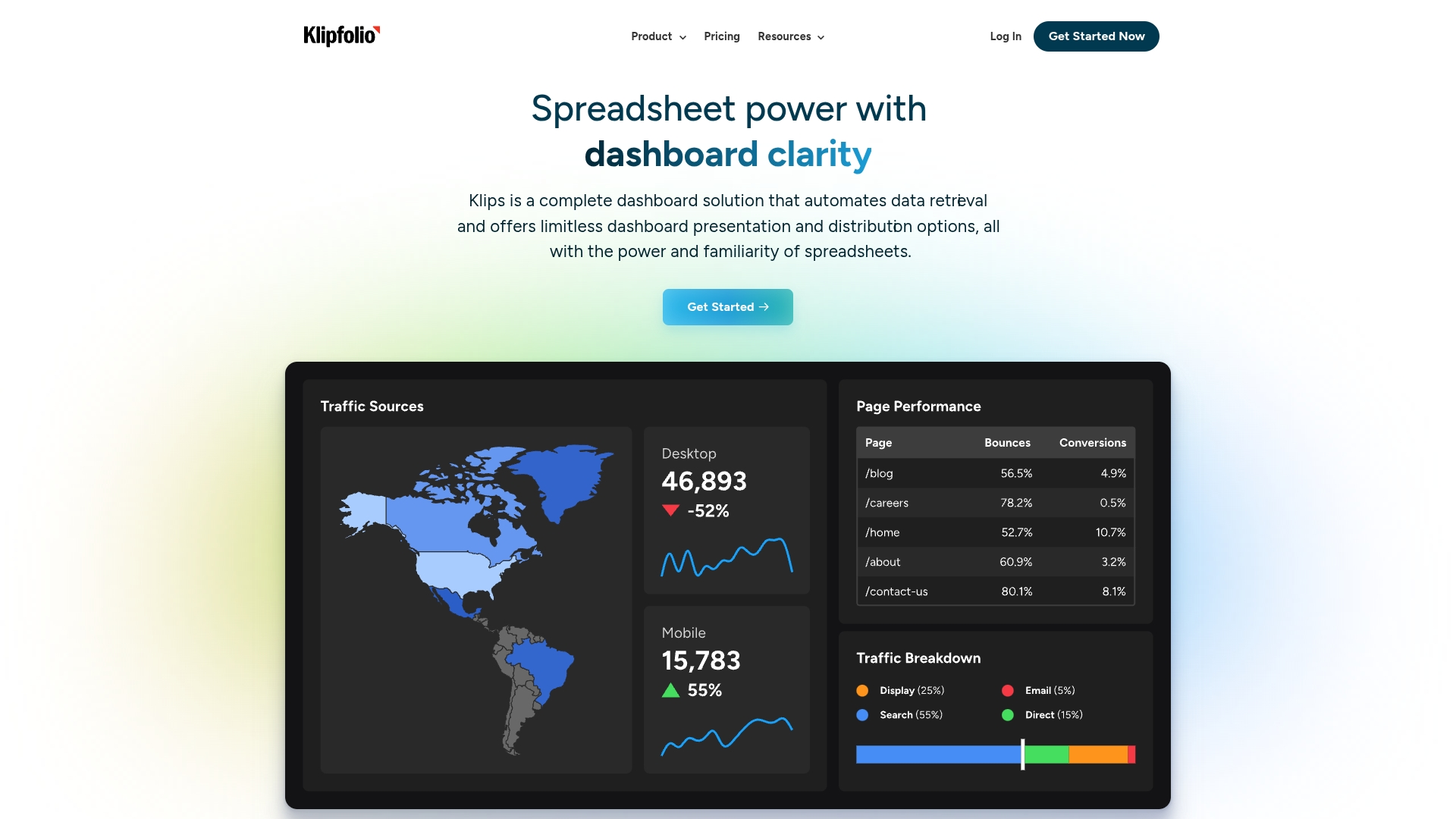
Use case: Klipfolio excels at consolidating data from multiple business applications into customizable, real-time dashboards that help teams track performance metrics and make data-driven decisions quickly.
Key features
- Real-time data monitoring with up-to-the-minute refresh capabilities across 130+ integrations including Google Analytics, Salesforce, and HubSpot
- Pre-built dashboard templates and metrics library that accelerates setup for common business functions like marketing, sales, and financial reporting
- Dual-product offering with Klips for detailed custom reporting tools and PowerMetrics for fast metric tracking and trend analysis
Pricing
- Base: $120/month (3 dashboards, unlimited users, 4-hour data refresh)
- Grow: $190/month (10 dashboards, unlimited users, 1-hour data refresh)
- Team: $310/month (20 dashboards, unlimited users, 15-minute data refresh)
- Team+: $600/month (40 dashboards, unlimited users, up-to-the-minute data refresh)
- All plans include 130+ data integrations and are billed annually
- 14-day free trial available
Considerations
- Steep learning curve for creating custom dashboards from scratch, particularly for non-technical users
- Some users report slower dashboard loading times compared to competitors and occasional limitations with API connectors not extracting 100% of data from sources
6. SimpleKPI
Prioritizing simplicity without sacrificing functionality, SimpleKPI offers straightforward tracking software designed to clarify complex performance data into actionable insights. The platform is ideal for small businesses and teams new to KPI management who want to get started quickly.
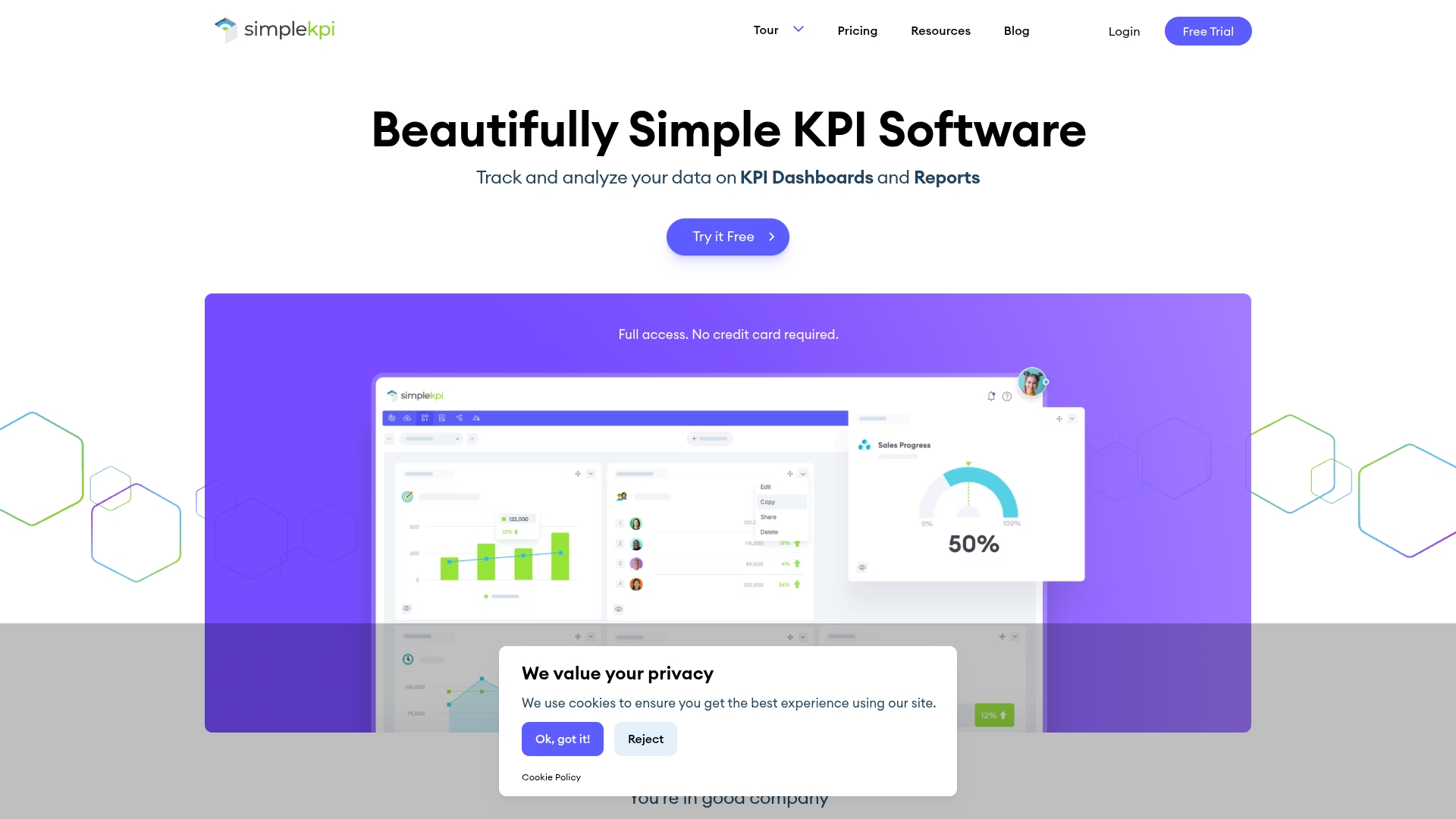
Use case: SimpleKPI helps organizations replace manual spreadsheet-based KPI tracking with automated dashboards and reports that provide real-time visibility into business performance.
Key features
- Real-time customizable dashboards with various charts, graphs, and widgets for instant performance visibility
- Extensive KPI library with industry-standard templates plus the ability to create custom KPIs with automated calculations
- Data integration from 5000+ business applications via API and connectors like Zapier, plus direct Excel spreadsheet imports
Pricing
- Single plan: $79/month (annual billing) or $99/month (monthly billing)
- Annual discount: 20% off when billed annually
- Quarterly discount: 10% off when billed quarterly
- Nonprofit discount: 50% off for charities, non-profits, and educational institutions
- Free trial: 14-day trial with no credit card required
Considerations
- Limited customization options for dashboards and reports compared to more advanced analytics platforms
- Users report occasional issues with date ranges in dashboards requiring manual correction
7. Databox
Built with a mobile-first philosophy, Databox consolidates scattered business metrics into a unified KPI tracking powerhouse that keeps your team focused on what matters most. Its pre-built dashboard templates make it perfect for remote teams and growing businesses that need instant access to their performance data.
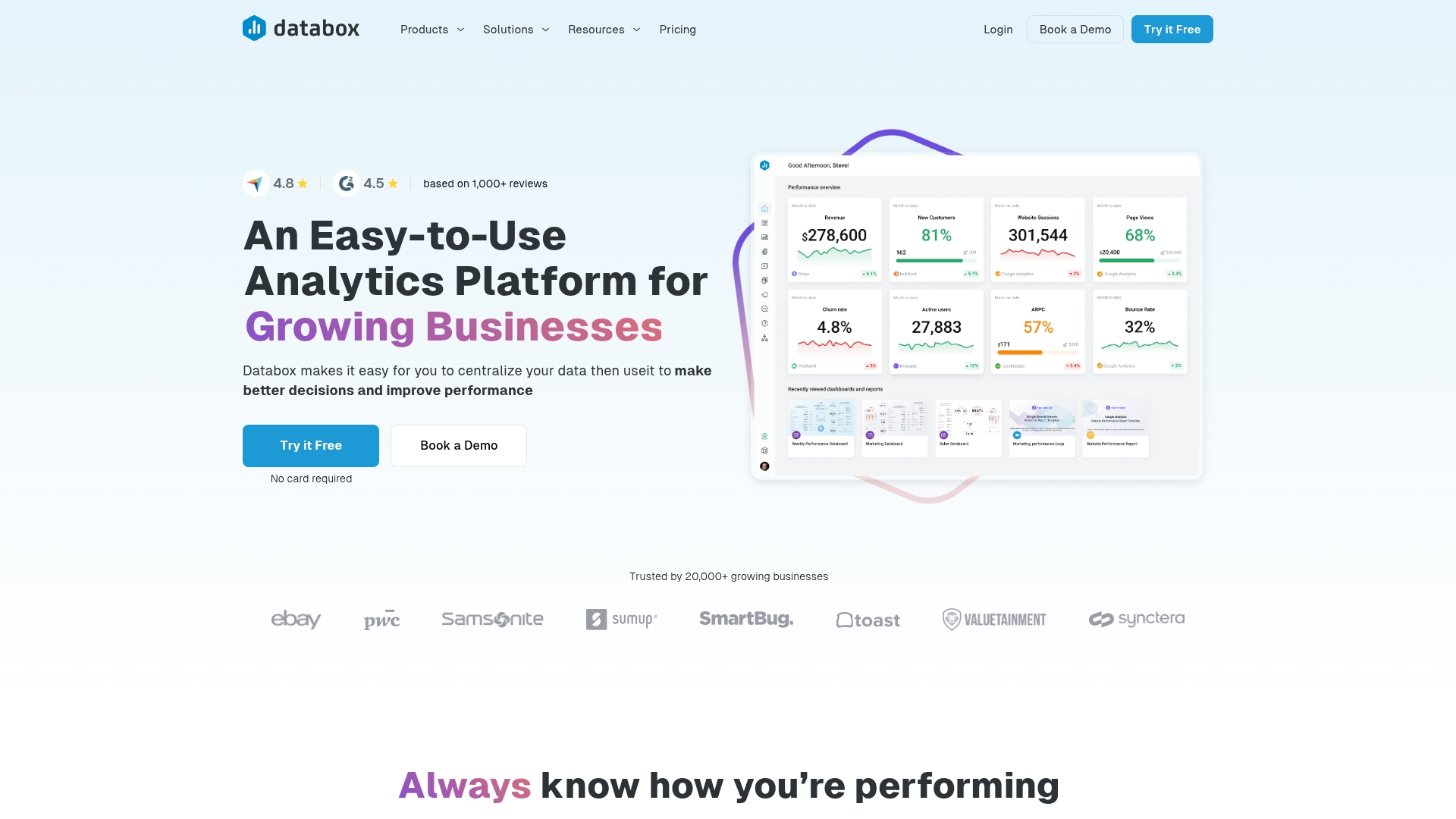
Use case: Databox centralizes KPI tracking and performance monitoring for teams that need real-time visibility into their most important metrics without the complexity of enterprise-level analytics platforms.
Key features
- Custom metric creation with no-code SQL builder and calculated metrics from multiple data sources
- AI-powered performance summaries that automatically explain data trends and fluctuations
- Goal tracking with SMART objectives, automated alerts, and industry benchmarking capabilities
Pricing
- Professional Plan: $159/month (includes 3 data sources, 24 months historical data)
- Growth Plan: $399/month (includes advanced analytics and AI features, unlimited historical data)
- Premium Plan: $799/month (includes 100 data sources, enterprise-grade support and security)
- Annual billing saves 20% across all plans
- Additional data sources cost $5.60/month each
Considerations
- Limited customization options for complex data analysis needs compared to enterprise BI tools
- Some users report occasional performance issues and broken templates that can disrupt workflow
8. Google Analytics
As the industry standard for digital performance, Google Analytics delivers comprehensive web analytics and KPI tracking for businesses looking to understand their online presence. The platform specializes in event-based measurement and seamless integration with Google’s marketing ecosystem, making it the go-to choice for organizations tracking website and app metrics.

Use case: Google Analytics helps businesses track customer interactions across websites and apps throughout the entire lifecycle, providing unified visibility into the customer journey across multiple platforms.
Key features
- Event-based measurement model that treats every user interaction as a distinct event for granular tracking
- Machine learning-powered insights that automatically surface trends and predict future customer actions
- Cross-platform attribution to understand the full user journey and marketing impact across devices
Pricing
- Google Analytics: Free for standard features
- Google Analytics 360: Enterprise pricing available upon request
Considerations
- Limited to digital metrics only, making it unsuitable for tracking offline KPIs or non-digital business processes
- Steep learning curve with GA4’s new interface and event-based model requiring different analytical thinking
9. DashThis
Designed to eliminate hours of manual work, DashThis provides automated marketing KPI reporting software that transforms scattered campaign data into polished, professional reports. The platform specializes in simplifying complex marketing analytics for agencies and marketing teams. With white-label capabilities and extensive integrations, it’s built specifically for professionals who need to showcase results to clients and stakeholders quickly.
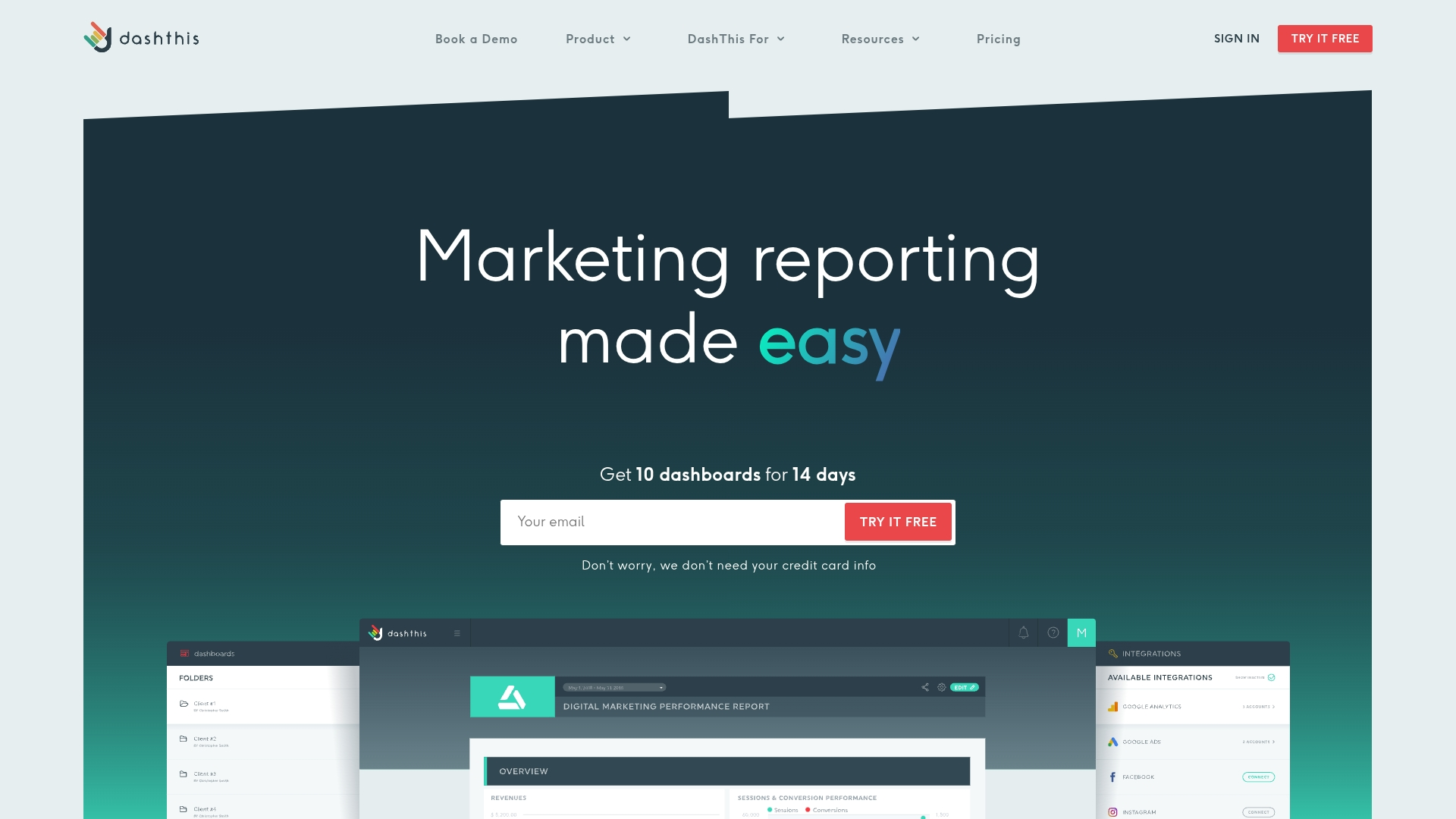
Use case: DashThis automates the creation of branded marketing reports by pulling data from over 34 platforms into customizable dashboards, saving agencies and marketing teams hours of manual work each month.
Key features
- Automated data collection from Google Analytics, Facebook, LinkedIn, and 30+ other marketing platforms
- Drag-and-drop dashboard builder with preset templates for different marketing strategies
- Complete white-label customization including logos, custom domains, and branded email delivery
Pricing
- Individual: $49/month or $42/month (billed annually) for 3 dashboards
- Professional: $159/month or $135/month (billed annually) for 10 dashboards
- Business: $309/month or $264/month (billed annually) for 25 dashboards
- Standard: $479/month or $409/month (billed annually) for 50 dashboards
- Custom plans are available for higher volume needs
- 15-day free trial with up to 10 dashboards
- 30% discount available for nonprofit organizations
Considerations
- Limited to marketing-focused KPIs, making it less suitable for broader business intelligence needs
- Pricing structure based on dashboard count can become expensive for agencies managing many clients
10. Smartsheet
Leveraging its familiar spreadsheet-like interface, Smartsheet translates complex data into actionable KPI insights. The platform specializes in customizable dashboards and metric tracking, making it ideal for teams who need powerful analytics without abandoning their Excel-like workflows.
Use case: Smartsheet enables organizations to create highly customizable KPI dashboards that aggregate data from multiple sources while maintaining the familiar feel of spreadsheet-based work management.
Key features
- Real-time dashboards with 30+ widget types for visualizing KPIs across departments
- Metric sheets that consolidate and calculate performance data from various sources
- Pre-built KPI dashboard templates for project management, sales, and efficiency tracking
Pricing
- Pro: $12/month per member (billed monthly) or $120/year per member (billed annually)
- Business: $25/month per member (billed monthly) or $228/year per member (billed annually)
- Enterprise: Custom pricing for 10+ members with advanced security and governance features
- Advanced Work Management: Custom pricing with premium connectors and support
- Add-ons like Dynamic View ($125/month) and Data Shuttle ($100/month) available for Business and Enterprise plans
Considerations
- Complex KPI setups require understanding of formulas and cross-sheet referencing, which can be challenging for non-technical users
- Mobile app functionality for dashboard creation and editing is limited compared to desktop experience
What to look for in a KPI software solution
Finding the right KPI software is about more than flashy dashboards. It’s about equipping your team with a tool that makes it easy to track progress, adapt fast, and stay laser-focused on what moves the needle. Here’s what to prioritize:
- Real-time, actionable dashboards. Your software should update live, so you’re always seeing the story as it unfolds, not just a snapshot of yesterday. Look for platforms that cut through the clutter and surface the metrics that actually drive your work forward.
- No-code customization. You shouldn’t need a data science degree to set up or adjust your dashboards. The best solutions let your team connect KPIs directly to projects, budgets, and timelines without technical barriers.
- Seamless integrations. Choose a tool that connects easily with your existing apps — think CRM, financial software, and project management tools, so you’re not manually chasing down updates or toggling between tabs.
- Powerful automations. Automate routine reporting, alerts, and next steps. The right platform will trigger actions the moment a KPI hits a threshold, keeping your team moving (and nothing slipping through the cracks).
- Scalability for every stage. Whether you’re a five-person startup or a global enterprise, your KPI software should grow with you — no need to rip and replace as your business evolves.
- Intuitive, adoption-ready design. If a platform feels clunky or confusing, nobody will use it. Prioritize solutions your team will actually open every morning, and that help everyone see how their work connects to the bigger picture.
- AI-powered insights. Don’t settle for retroactive reporting. Modern KPI tools put AI to work spotting risks, forecasting outcomes, and translating complex trends into plain-English recommendations, so you’re always one step ahead.
With monday work management as your business intelligence tool, you get all of this in a platform that’s built to unify your team’s goals, automate the busywork, and turn real-time data into real results.
Try monday work managementHow to choose a KPI management platform

Choosing the right KPI platform means finding a tool that brings clarity and momentum to your team’s day-to-day. Here are simple steps to guide your decision:
- Pinpoint your pain points. Are you stuck reconciling data from a dozen sources? Wasting time on spreadsheets no one trusts? Or maybe your teams can’t see how their work connects to the bigger picture. Identify what’s slowing you down right now.
- Prioritize usability and adoption. If a platform feels complicated or clunky, it won’t get used — no matter how many features it has. Look for a solution your team will actually want to open every morning.
- Demand real-time visibility. Outdated dashboards mean you’re always reacting to the past. The best platforms update automatically, giving you a live look at what matters most, so you can act, not just analyze.
- Seek seamless integration. Your KPI software should work hand-in-hand with the tools you already rely on, eliminating data silos and manual updates for good.
- Scale with confidence. Whether you’re a team of five or five hundred, the right platform grows with you — no rebuilding required as your needs evolve.
When you choose a Work OS like monday.com, you’re building a single source of truth that streamlines KPI tracking, unites your team, and transforms data into action at every level.
How to avoid common pitfalls in KPI reporting
KPI reporting can quickly go off track if you’re not careful about a few key challenges. The first is conflicting metrics: when teams use different definitions or sources for the same KPI, alignment breaks down and you end up with competing narratives. The solution? Establish a single source of truth with a unified dashboard, so everyone’s tracking the same numbers, with the same definitions, in real time. This creates one version of success that every team can rally around.
Another major obstacle is working with stale or incomplete data. Relying on manual updates or disconnected spreadsheets means you’re reacting to yesterday’s problems, not today’s opportunities. The fix is automation and AI: connect your data sources, set up live dashboards that update automatically, and let AI surface anomalies or risks you might otherwise miss.
Finally, context is everything. Numbers alone can’t tell you what’s truly happening. They need to be tied to real projects, owners, and next steps. Without that connection, even the most impressive metrics lose their meaning. The answer is to build KPI dashboards that don’t just show the “what,” but also the “why” and the “now what,” linking every dip or spike to the actual work and decisions behind it. That’s how you turn raw data into real results.
Bridge the gap between metrics and meaningful results
If you’re ready to move beyond simply tracking metrics and start driving real results, monday work management is your missing link. It closes the gap between your KPIs and the day-to-day work that delivers them, giving your team clarity, alignment, and momentum. No more disconnected dashboards or guessing games: Every initiative, task, and milestone is tied directly to your most important goals, so you always know what’s moving the needle.
With monday work management, you transform uncertainty into action. Your team gains complete visibility into progress, can pivot faster, and celebrates real wins — not just numbers on a screen. It’s your platform for turning scattered data into a unified story of achievement, empowering everyone to see their impact and take ownership of outcomes.
Ready to unlock clarity and confidence at every level? Try monday work management and turn your KPIs into real progress, every single day.
Try monday work managementFAQs
Can I use KPI software free without losing essential features?
Yes, many free plans offer core tracking features for individuals or small teams. Advanced capabilities like AI insights and unlimited integrations are typically part of a paid subscription that scales with you.
Which KPI management tool has the most AI capabilities?
While BI tools offer deep AI analytics, monday work management embeds AI directly into your workflows to automate tasks and provide actionable insights. This focus on execution helps teams move work forward instead of just analyzing past performance.
How do I synchronize data across multiple systems into my KPI dashboard?
The best KPI tools use pre-built integrations and flexible APIs to automatically sync data from other systems like Salesforce or Jira. This ensures your dashboard always reflects real-time information without manual data entry.
Can KPI software help remote and hybrid teams track performance?
Yes, cloud-based KPI software is built for remote and hybrid teams, offering real-time access to shared dashboards from any device. Centralized data keeps everyone aligned on key metrics, no matter where they work.
How do I measure ROI on a KPI platform investment?
Measure ROI by quantifying time saved on manual reporting, faster decision-making, and improved goal attainment. Track metrics like reduced project delays and increased team efficiency to see a clear return on your investment.
What is the difference between KPI software and business intelligence tools?
KPI software is designed for tracking specific, real-time metrics to manage team performance and execution. Business intelligence (BI) tools are built for broader, more complex data analysis and historical reporting.
 Get started
Get started 

